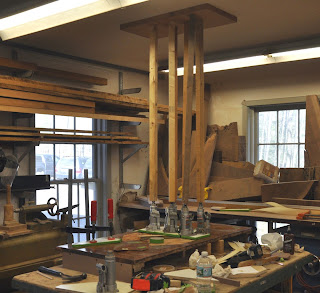ok ... miracles still do happen ... i managed to get the veneer on this top back to flat. see the full story below, and click the photos to enlarge them, especially of the 'before' top 2 images below ...
4/22/2015
well, the boys in the shop kind of shook their heads when i came in the door with the top from this bureau. it's austrian, maybe. the clients bought the bureau in australia in the late 60s. it's a very cool piece with serious veneer isues on the top ..
click the photos to enlarge them ... really .. this is a cool piece.
it's definitely old .. the veneers are hand sawn and about a thin 1/8th" thick. i can't be sure what the wood is yet, but the bureau exhibits classical construction joinery and an obvious high level of builder skill. but the top !!! ooo weee! can we fix that? we'll see.
step 1 .. start slowly. pry at the pieces and see what happens .. wow, they sort of pop off easily! it looks like they were applied with hot hide glue and tapered hand whittled square pegs. a bunch of them at that.
here are some of the pegs, and they
really work ... i'll have to figure out how to make these when i put the top veneers back together.
i decided that at some point i would have to flatten the top and decided to do it sooner rather than later. once i got the top off the case it got even more humped up, but after a struggle, and some kerfing, it's a lot closer to flat
stay tuned. i think tomorrow i will make the kerfs a little deeper to remove more of the stress. the cleats are 3/4" quartered white oak and they couldn't draw the top flat. it might be easier if i remove more of the veneer. then i'll try to get the glue off the backs of the veneer pieces, which you can now flatten out easily by hand .. the subtop is pine, and the old hide glue pops right off that. i'm starting to have some hope, even though i've really only just begun.
4/24 .. a little more progress today .. i think i've got everything off that's coming off and the top has flattened out quite a bit
i might make a few of the kerfs a little deeper monday, and then fill them in with pine wedges, then glue a piece of 1/16th walnut veneer to the bottom to balance the panel .. it should stay flat then ... i hope ... we'll see
update 5/13/2015
ok .. i've been working on this off and on for about 3 weeks, but i finally whipped it yesterday .. i was able to reglue all the original pieces
with their original finish back flat onto the original top. i'll be installing it back on the bureau on friday morning. the owner came by yesterday to see it and she was totally thrilled ... i think i made hero status, for her at least. below are a series of photos
showing the reinstallation of the pieces
there were some repairs made to this piece in the past with non hide glue so i had to glue some of the loose edges down without removing the entire piece .... no problem, just added more time to the cycle for the glue to dry. this was just one of many contemplative moments in the process ..

this is typical of the pieces i was able to get off ..
as you can imagine from the previous photo, there were some highs and lows after we scraped the old glue off. i was able to shim the low spots by trial and error with some 40th inch maple veneers
one piece at a time with some time between each clamping for the glue to set up. i had to remove the clamps and cauls several times to clean off the hide glue squeeze out as the glue set up.
the melamine clamp cauls worked slick.. the plywood ones we covered with packing tape, which was also effective. in all glue ups shown here, and in most other antique repairs described on this blog, i used
franklin liquid hide glue for future reversability.
as i got to the middle of the top, i had to switch to my original, from the 80s, hydraulic jack clamping concept. i've got about 10 of them from when before vacuum veneer bags were readily available and affordable. i even had the sticks, and the blocks were still on the ceiling
so, all in, all done .. i'm gonna take a bow now and go have a guinness ..
5/15/15
can't resist posting a few on site photos
before





















































